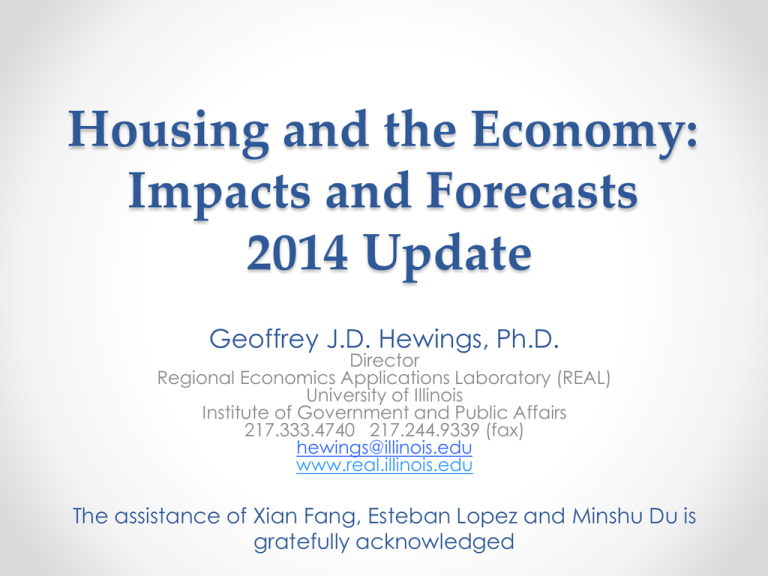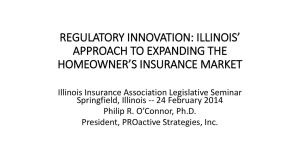Housing and the Economy: Impacts and Forecasts 2014 Update
advertisement

Housing and the Economy: Impacts and Forecasts 2014 Update Geoffrey J.D. Hewings, Ph.D. Director Regional Economics Applications Laboratory (REAL) University of Illinois Institute of Government and Public Affairs 217.333.4740 217.244.9339 (fax) hewings@illinois.edu www.real.illinois.edu The assistance of Xian Fang, Esteban Lopez and Minshu Du is gratefully acknowledged Outline o Update on the economy o Housing market and forecasts o Launch of a companion price index for Illinois and metro areas o In progress: Impact of foreclosures 2013 Highlights Last half of 2012 revealed positive changes in prices Significant increase in sales volume and sustained price recovery in 2013 Resolution of foreclosure issues saw significant increase in foreclosed properties Consumer optimism dampened by “fiscal cliff” and Government shutdown in Washington and the failure of Illinois state government to address deficit Combination of enhanced inventory, historically low interest rates and accelerating costs of renting fueled the housing market in 2013 Update on the economy Number of Jobs Gained/Lost for Illinois 2000-2013 (000s) 150 100 50 0 -50 -100 -150 -200 -250 Four years of solid job creation -300 2000 2001 2002 2003 2004 2005 2006 2007 2008 2009 2010 2011 2012 2013 3.00% Illinois, Rest of Midwest and US Annual Employment Growth Rates (%) 2.00% 1.00% 0.00% Illinois -1.00% RMW US -2.00% -3.00% -4.00% -5.00% 2000 2001 2002 2003 2004 2005 2006 2007 2008 2009 2010 2011 2012 2013 o 2010 and 2012, Illinois exceeded or matched US growth rates o Only happened twice since 1980 o But…… The hill to climb…. • State is 220,000 jobs below prior peak (November 2000) “ But…need to add considerations of: • • • population growth since 2000 decrease in labor force participation rates Large number in part-time who would like full-time employment THEN… State of Illinois Economies o State probably needs to add close to: 707,000 jobs to achieve equivalent level to November 2000 RECOVERY: How long will it take? o o o Before this recession, longest recovery was 8 years (now > 13 years – since 2000) Current employment in Illinois matches that late 1990s Illinois still has 5 of 10 sectors with employment levels below those of 1990: Manufacturing, Information, Construction, Trade, Transportation & Utilities, and Financial activities Illinois Metro Areas o How well are they doing compared to Chicago and the state? o What are the forecasts? o Developed monthly employment analysis and 12 month ahead employment forecasts o Also developed an Index of Leading Indicators for each MSA The Metro Indices Compared with Chicago’s Performance Comparing MSAs Indices with Chicago Indices 50.00 40.00 30.00 20.00 10.00 0.00 -10.00 -20.00 -30.00 Bloomington Champaign Davenport Decatur Peoria Rockford Springfield Kankakee Value above line indicate growth > Chicago Metro Area Economic Performance last 12 months Housing Market How Good were our Forecasts? Illinois Housing Market: Prices Illinois Housing Market: Sales Chicago Housing Market: Prices Chicago Housing Market: Sales Illinois Housing Market: Supply Illinois Housing Market: Price Stratification Illinois Housing Market: Price Forecast 2014 Annual Sales Change by Month (month this year compared to last year) Downward Trend of Concern? But signs of upward trend last 2 months.. Final Concerns o o o o Signals in the economy and in the housing market continue to be “noisy” Signs that Congress is finally accepting its responsibility to govern State has made some “progress” on facing fiscal issues but…. Firms would like to locate/expand in the state but have little faith in the state’s fiscal management Launch of the REAL Index o o o o REAL, along with NAR publishes a median price index Problem: price changes may not fully reflect differences in the characteristics of houses sold one month versus next month Case-Schiller index provides “perfect match” by comparing same house – but only available for top 20 markets But: o Repeat sales may not fully represent mix of sales o Not suitable for small Metro areas Launch of the REAL Index (2) Median Home Sales Prices o The median is the half point between the largest and smallest value of a sample of houses. o It is misleading when: o Sales prices do not appreciate equally throughout the distribution (i.e. more appreciation in the lower-priced homes or in the higher-priced homes). o Changes in consumption patterns for characteristics (i.e. preferences relative change for number of bathrooms, bedroom etc.) Launch of the REAL Index (3) Launch of the REAL Index (4) Launch of the REAL Index (5) Launch of the REAL Index (6) Launch of the REAL Index o Starting in January, issue two indices for Chicago and Illinois o One based on median prices (as before) o One based on housing characteristics o For the quarterly Metro area forecasts, provide the same two price indices o Attempt to expand the number of characteristics associated with houses sold o Attempt to highlight whether price appreciation is coming from different characteristics or truly represents price appreciation based on similar characteristics o Look for your feedback next year Impact of Foreclosures Impact of Foreclosures o o o Examined the impact of foreclosures on property prices in Chicago Foreclosures have negative impacts not just for the homeowner, but also on neighboring property values. REAL conducted a study to investigate the impact of foreclosures over time on nearby property values Spatial Units Neighbourhood buffers. Nearby neighbourhood: 0-0.1 miles and Distant neighbourhood: 0.1-0.2 miles and 0.2-0.3 miles Foreclosure Timeline Division of foreclosure timeline. “A” indicates “Auction”; 1 unit indicates one quarter; “+” indicates after auction and “-” indicates before. Foreclosure Impacts: Results Foreclosure Impacts: Results o On average, no impacts before the auction; -2% to -1% during the two years after the auction o One more foreclosed property can reduce nearby property values: (calculated at median housing price of $250K) o In the first year: $2,100 o In the second year: $3,000 Impacts by Vacancy Rate Quartile Foreclosure Impacts o At current rates, expect to return to prerecession foreclosure rates in late 2014 or 2015 Final Remarks o A recent CRAINS survey revealed more renters in Chicago more favorable to buying – inching up homeownership rates to 68.1% compared to 66.9% in 2012 o Increasing construction of multifamily units (and new construction generally) will put pressure on rental markets o Concerns focus on impacts on (1) housing affordability and (2) impact of increasing inequality on housing demand Final Remarks (2) o According to NAR, year-over-year affordability index decreased 16.1% nationwide in third quarter and 14.1% in Midwest o US now second to UK in income inequality (before taxes) and first after taxes – empirical evidence accumulating that this has negative impact on long-term growth but debate is contentious Monthly index of leading indicators for Chicago L Monthly Employment analysis for state and Metro areas Illinois Economic Review (monthly) with employment forecasts for next 12 months For More Information www.real.illinois.edu www.illinoisrelator.org/marketstats







